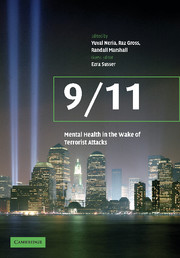Book contents
- Frontmatter
- Contents
- Acknowledgments
- Editors brief bio
- List of contributors
- Foreword
- Part I Introduction
- Part II The psychological aftermath of 9/11
- Part III Reducing the burden: community response and community recovery
- Part IV Outreach and intervention in the wake of terrorist attacks
- Part IV A New York area
- Part IV B Washington, DC
- Part IV C Prolonged-exposure treatment as a core resource for clinicians in the community: dissemination of trauma knowledge post-disaster
- Part V Disasters and mental health: perspectives on response and preparedness
- 29 The epidemiology of 9/11: technological advances and conceptual conundrums
- 30 Searching for points of convergence: a commentary on prior research on disasters and some community programs initiated in response to September 11, 2001
- 31 What mental health professionals should and should not do
- 32 Coping with the threat of terrorism
- 33 Life under the “new normal”: notes on the future of preparedness
- 34 Lessons learned from 9/11: the boundaries of a mental health approach to mass casualty events
- 35 Learning from 9/11: implications for disaster research and public health
- Index
31 - What mental health professionals should and should not do
from Part V - Disasters and mental health: perspectives on response and preparedness
Published online by Cambridge University Press: 27 October 2009
- Frontmatter
- Contents
- Acknowledgments
- Editors brief bio
- List of contributors
- Foreword
- Part I Introduction
- Part II The psychological aftermath of 9/11
- Part III Reducing the burden: community response and community recovery
- Part IV Outreach and intervention in the wake of terrorist attacks
- Part IV A New York area
- Part IV B Washington, DC
- Part IV C Prolonged-exposure treatment as a core resource for clinicians in the community: dissemination of trauma knowledge post-disaster
- Part V Disasters and mental health: perspectives on response and preparedness
- 29 The epidemiology of 9/11: technological advances and conceptual conundrums
- 30 Searching for points of convergence: a commentary on prior research on disasters and some community programs initiated in response to September 11, 2001
- 31 What mental health professionals should and should not do
- 32 Coping with the threat of terrorism
- 33 Life under the “new normal”: notes on the future of preparedness
- 34 Lessons learned from 9/11: the boundaries of a mental health approach to mass casualty events
- 35 Learning from 9/11: implications for disaster research and public health
- Index
Summary
Introduction
I don't live in America, let alone in New York. I live in Central London under the Heathrow flight path. It was not long ago that my house was shaken by the final flights of the last three Concordes. On September 11, 2001, we experienced the opposite, a strange week of silence, when all flights were banned for a week. And when they resumed for a while I looked out of my window as each plane came past and experienced a frisson of anxiety. Like virtually everyone I know, it took sometime to shake off those hypnotic images imprinted in my memory from those hours glued to our TV screens throughout the horrors of that first day.
But not for a moment did I consider that I had a problem, let alone seek help for it.And after a few weeks these emotions disappeared. Yes, my view of the world had changed, as had my appraisal of the society we live in and the threats we face. The world seemed, and probably was, a riskier place (Halpern-Felsher & Millstein, 2002; Roberts & Em, 2003). But emotionally and physically I felt the same as I had been before, for better or worse.
When I visited America only a few weeks later, to take part, ironically, in a prearranged conference on psychological responses to mass violence (National Institute of Mental Health, 2002), I observed something else. September 11th had also brought about positive changes in the society that I have visited so many times.
- Type
- Chapter
- Information
- 9/11: Mental Health in the Wake of Terrorist Attacks , pp. 543 - 569Publisher: Cambridge University PressPrint publication year: 2006

